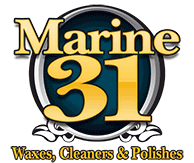Polishing a Boat
Gel-coat is a term used to describe the pigmented or colored outer surface of a fiberglass boat. Fiberglass is a combination of polyester resin with glass woven fabric to create flexibility with strength.
Although gel coat finishes are very hard and durable, when exposed to oxygen in the air and in water, a chemical breakdown process occurs that we call oxidation.
Oxidation is basically the gel-coat material deteriorating and this shows up to us visually as a dull, rough and chalky looking finish.
If oxidation is left uncorrected, it will accelerate. The rough, deteriorated surface will retain water inside its top layer more than a smooth, hard, shiny, protected surface. It's best to put your boat on a regular maintenance program that includes:
- Washing
- Compounding (if needed)
- Polishing
- Sealing with a wax or sealant
Depending on the size of your boat, you may find it much easier to use a polisher to remove oxidation, polish to a high gloss and the seal the gel-coat surface.
Rotary Buffers
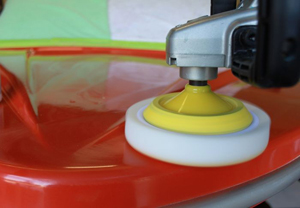
A rotary buffer, also called a rotary polisher with a wool pad is ideal for cutting out gel coat oxidation. Rotary buffers are what we call direct drive tools and they offer plenty of power when used with a quality wool pad and a quality marine compound to remove the chalky oxidation and restore a smooth, hard surface.
If the gel-coat finish on your boat has mild to severe oxidation then the fastest and most effective way to remove the oxidization is with a wool pad and a premium quality marine cutting compound. The good news is that the FLEX PE14-2-150 Circular Polisher is compact and lightweight so it makes buffing out vertical sides easy and a lot less fatiguing than old fashioned rotary buffers. The Flex PE-14-2 weighs in at approximately 5 pounds but has all the power of a full size rotary buffer and even better, has a low RPM speed of 600 RPM, so you pick the right speed for your needs and preference.
Besides being light, easy to hold and operate, the Flex PE-14-2 Rotary Buffer is designed to run cool even at low RPM's so the tool won't get hot and it's actually designed to be used with a handle or there's a molded-in grip at the head of the unit to give you maximum control over the polisher by placing your hand directly on the head of the unit. This also reduce muscle fatigue enabling you to better tackle large boat hulls.
The Makita 9227C Polisher is a heavy duty 10 amp rotary buffer with variable speeds. It's a heavier machine than newer models, but it has long been trusted by professional detailers for its dependable performance and powerful motor.
Dual Action Orbital Polishers
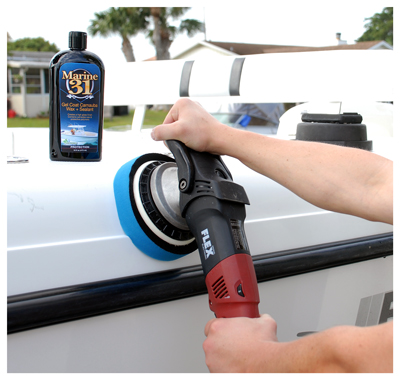 A dual action, orbital polisher, like the Porter Cable 7424XP or Flex XC3401 can be used for mild oxidation removal, regular light polishing, and wax application. These types of tools are the easiest types of tools to learn how to use and make detailing your boat faster and easier than working by hand. Thanks to its forced rotation direct drive orbital action, the Flex XC3401 is the choice for boating enthusiasts who want to get the job done faster.
A dual action, orbital polisher, like the Porter Cable 7424XP or Flex XC3401 can be used for mild oxidation removal, regular light polishing, and wax application. These types of tools are the easiest types of tools to learn how to use and make detailing your boat faster and easier than working by hand. Thanks to its forced rotation direct drive orbital action, the Flex XC3401 is the choice for boating enthusiasts who want to get the job done faster.
There are a wide range of buffing pads available for these tools so you can match the right pad to the condition of your boat's gel-coat finish for maximum results.
You can also get brushes for both of these tools which can be used to machine scrub non-skid surfaces as the bristles can get down into the cracks and crevices of the non-skid surface to make cleaning faster and easier than using a hand-held brush or broom.
Compounds
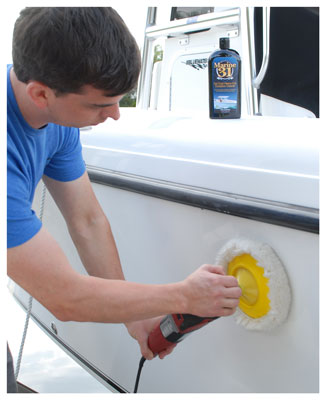 There are many boat polishes to choose from but your boat's condition will help you decide on the right polish. If your boat has heavy oxidation, Marine 31 Gel Coat Heavy-Cut Oxidation Cleaner has the cutting power to restore old gel coat that has never been polished. It will also remove stains, scratches, and scuffs. Best results is achieved when using a rotary buffer with a wool cutting pad.
There are many boat polishes to choose from but your boat's condition will help you decide on the right polish. If your boat has heavy oxidation, Marine 31 Gel Coat Heavy-Cut Oxidation Cleaner has the cutting power to restore old gel coat that has never been polished. It will also remove stains, scratches, and scuffs. Best results is achieved when using a rotary buffer with a wool cutting pad.
Spurs and Pad Washers
Because you'll be removing a lot of dead, dull oxidized gel-coat you'll need to clean your wool pad often and to do this you'll want a Spur at a minimum and if you have a large boat you should even consider a Pad Washer like the Marine 31 Universal Pad Washer, which can be used with both wool and foam pads and any kind of polisher.
Polishes
If your boat has only the first signs of oxidation thin instead of a using a compound you can use a light polish which are usually referred to as color restorers because the result of using a light polish is to restore the color of the gel-coat or in the case of a white hull, it will restore the brightness and shine.
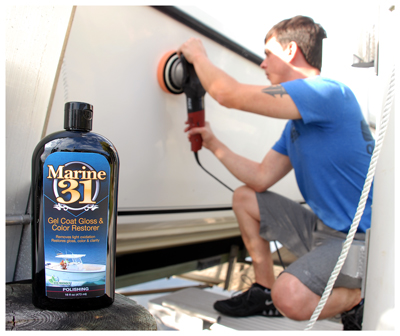 For a light oxidation, staining and built-up grimy films, you can use Marine 31 Gel Coat Gloss & Color Restorer. This product comes in liquid forum and can be applied by hand or machine. Marine 31 Gel Coat Gloss & Color Restorer is a popular choice because it can be used in direct sunlight.
For a light oxidation, staining and built-up grimy films, you can use Marine 31 Gel Coat Gloss & Color Restorer. This product comes in liquid forum and can be applied by hand or machine. Marine 31 Gel Coat Gloss & Color Restorer is a popular choice because it can be used in direct sunlight.
For the ultimate high gloss finish, after removing any oxidation and stains, apply Marine 31 Gel Coat Final Step Polish. Marine 31 Gel Coat Final Step Polish is a lightly abrasive polish that has a high content of rich polishing oils that will gorge the pores of a gel-coat finish to maximize color, gloss and shine. This is an optional step and it should only be used on new boats or after first restoring the surface using compounds and/or cleaner polishes like referenced above. This product is not a wax and is water soluble, so it MUST be topped with a marine boat wax or sealant to lock in the shine it produces.
While an optional step, the polishing oils help prevent and slow down oxidation by feeding the gel-coat and thus penetrating into and filling pores and other microscopic imperfections so water cannot fill these areas and thus cause oxidation.
Boat Polishing Tips:
- Work section by section. Polishing a boat is a big job.
- Keep a stack of microfiber towels close at hand to buff as you complete each section. It's even better if you can get someone to help!
- Anytime you're using a rotary buffer with wool pads and compounds it's a good idea to wear safety glasses.
- Depending on the size of the boat and the amount of oxidation, you may need several pads to complete the job. A pad conditioning brush or spurring tool will help you restore the texture of wool pads when they become caked, so you can continue using them.
- Keep a bucket of pad cleaning solution close by. When you're finished using each pad, toss it into the solution to make cleanup easier.
Gel coat surfaces are not only very hard but they are also very thick as compared to automotive clear coats. Polishes made for the marine vessels are more specifically designed for gel-coat finishes. You'll get better results faster by sticking with products formulated for the marine industry.
The end of each boating season is a good time to thoroughly polish a boat. By removing oxidation and algae stains and then sealing the boat with wax, you'll ensure that it's ready to go next year.
